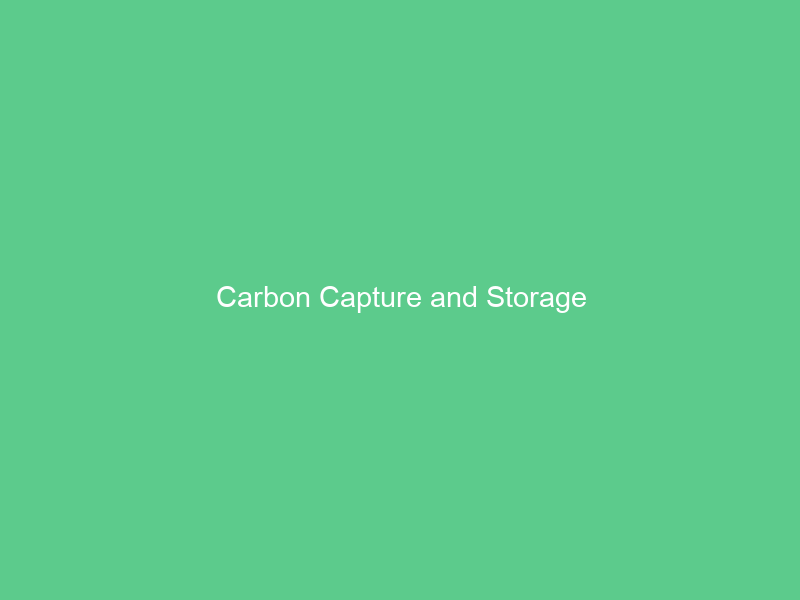
Carbon Capture and Storage (CCUS) technology can significantly lower carbon dioxide emissions from power plants, industrial processes and fossil fuel extraction operations. Once captured, captured CO2 can then be safely stored underground within geological formations.
CCUS requires large volumes of CO2, which must be transported to storage sites where it will be injected into deep geological formations such as saline aquifers or depleted oil and gas reservoirs.
Capture
Carbon Capture and Storage (CCS) is an emerging technology which “scrubs” carbon dioxide emissions from fossil-fueled power plants and other industrial facilities and transports and stores it underground – safely and permanently.
CCS technology is only being implemented on a limited scale at coal and natural gas power plants as well as energy intensive industries like steel mills. But its potential can significantly reduce greenhouse gas emissions from all fossil-fuel sources including oil – helping countries meet their net zero climate goals more quickly.
Carbon dioxide can also be recycled as an economical raw material to produce products such as jet fuel, automobile seats and building materials such as cement. Companies and labs are exploring technologies to transform carbon dioxide into these useful items as well as futuristic ones such as graphene or carbon fibers. Furthermore, enhanced oil recovery uses CO2 injection into active oil fields in order to extract more crude oil reserves.
Transport
CCS projects use CO2 capture technology to separate it from other gases, compress it, and transport it via pipelines or ships to locations where geological formations provide permanent storage for it. Existing natural gas and oil pipelines may even be reconfigured to transport captured carbon dioxide.
Carbon Capture, Utilization and Storage (CCUS) technologies can capture CO2 emitted by power plants and industrial facilities and store it either permanently underground or use it productively in products like concrete and biofuel.
Compressed or liquefied carbon dioxide (known as supercritical CO2) takes up less space when compressed or liquefied, making its transportation through pipelines simpler and safer. Today there are over 50 CO2 pipelines operating worldwide and these pipes adhere to the same stringent safety standards as any other natural gas or oil pipeline, meaning there’s no additional risk associated with carbon dioxide transportation than there would be for other fossil fuels.
Utilization
Companies using CO2 capture processes can transform it into useful products to help decarbonize the economy, such as fertilizer (through direct use pathways or urea production) or synthetic hydrocarbon fuels produced via Fischer-Tropsch or fermentation technology.
Point-source capture systems can also help increase the efficiency of power plants and industrial processes. At present, 13 projects are operating and storing carbon dioxide captured from power plants as well as other facilities like cement and steel factories.
Utilizing captured carbon is essential to making CCS more affordable. Nontransformative processes may also be used to produce energy from it, including carbonation of drinks or use as a dry cleaning agent. Storage of CO2 occurs by pumping it deep underground in geological formations such as saline aquifers. In some instances carbon can be stored temporarily while others it will be permanently stored.
Storage
Carbon capture and storage (CCS) refers to technologies that enable fossil fuels to be utilized without contributing significantly to climate change. Captured CO2 can either be stored underground or put to use in industrial processes – known as “utilization,” giving rise to its acronym: CCUS (carbon capture, utilization and storage).
Post-combustion carbon capture separates CO2 from other gases in flue gas with chemical solvents, while oxyfuel technology burns fuel with pure oxygen to produce carbon-dioxide-rich exhaust gas, making it possible to capture. CO2 captured at one plant will then be transported for storage usually via pipeline but may occasionally travel via ship or rail.
Once at the storage site, CO2 is injected deep underground to be stored permanently in geological formations such as former oil and gas reservoirs or deep saline formations. Unfortunately, the injection process is expensive and facilities must be located a reasonable distance from storage locations to make CCUS projects financially feasible; only with support from governments and industry can these projects become financially sustainable.

